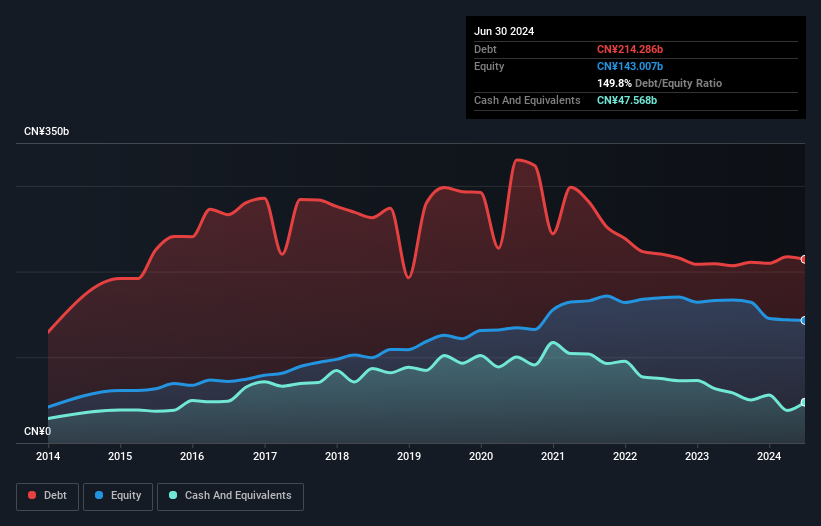- China
- /
- Real Estate
- /
- SHSE:600606
Health Check: How Prudently Does Greenland Holdings (SHSE:600606) Use Debt?

David Iben put it well when he said, 'Volatility is not a risk we care about. What we care about is avoiding the permanent loss of capital.' So it seems the smart money knows that debt - which is usually involved in bankruptcies - is a very important factor, when you assess how risky a company is. Importantly, Greenland Holdings Corporation Limited (SHSE:600606) does carry debt. But the real question is whether this debt is making the company risky.
When Is Debt Dangerous?
Debt assists a business until the business has trouble paying it off, either with new capital or with free cash flow. If things get really bad, the lenders can take control of the business. However, a more common (but still painful) scenario is that it has to raise new equity capital at a low price, thus permanently diluting shareholders. Having said that, the most common situation is where a company manages its debt reasonably well - and to its own advantage. The first thing to do when considering how much debt a business uses is to look at its cash and debt together.
See our latest analysis for Greenland Holdings
What Is Greenland Holdings's Debt?
As you can see below, Greenland Holdings had CN¥214.3b of debt, at June 2024, which is about the same as the year before. You can click the chart for greater detail. However, it does have CN¥47.6b in cash offsetting this, leading to net debt of about CN¥166.7b.

A Look At Greenland Holdings' Liabilities
According to the last reported balance sheet, Greenland Holdings had liabilities of CN¥796.4b due within 12 months, and liabilities of CN¥130.4b due beyond 12 months. Offsetting this, it had CN¥47.6b in cash and CN¥279.5b in receivables that were due within 12 months. So it has liabilities totalling CN¥599.7b more than its cash and near-term receivables, combined.
The deficiency here weighs heavily on the CN¥20.7b company itself, as if a child were struggling under the weight of an enormous back-pack full of books, his sports gear, and a trumpet. So we definitely think shareholders need to watch this one closely. At the end of the day, Greenland Holdings would probably need a major re-capitalization if its creditors were to demand repayment. The balance sheet is clearly the area to focus on when you are analysing debt. But ultimately the future profitability of the business will decide if Greenland Holdings can strengthen its balance sheet over time. So if you want to see what the professionals think, you might find this free report on analyst profit forecasts to be interesting.
Over 12 months, Greenland Holdings made a loss at the EBIT level, and saw its revenue drop to CN¥302b, which is a fall of 26%. That makes us nervous, to say the least.
Caveat Emptor
Not only did Greenland Holdings's revenue slip over the last twelve months, but it also produced negative earnings before interest and tax (EBIT). Indeed, it lost CN¥1.1b at the EBIT level. When you combine this with the very significant balance sheet liabilities mentioned above, we are so wary of it that we are basically at a loss for the right words. Like every long-shot we're sure it has a glossy presentation outlining its blue-sky potential. But the reality is that it is low on liquid assets relative to liabilities, and it burned through CN¥7.9b in the last year. So is this a high risk stock? We think so, and we'd avoid it. The balance sheet is clearly the area to focus on when you are analysing debt. But ultimately, every company can contain risks that exist outside of the balance sheet. For example, we've discovered 1 warning sign for Greenland Holdings that you should be aware of before investing here.
If you're interested in investing in businesses that can grow profits without the burden of debt, then check out this free list of growing businesses that have net cash on the balance sheet.
New: Manage All Your Stock Portfolios in One Place
We've created the ultimate portfolio companion for stock investors, and it's free.
• Connect an unlimited number of Portfolios and see your total in one currency
• Be alerted to new Warning Signs or Risks via email or mobile
• Track the Fair Value of your stocks
Have feedback on this article? Concerned about the content? Get in touch with us directly. Alternatively, email editorial-team (at) simplywallst.com.
This article by Simply Wall St is general in nature. We provide commentary based on historical data and analyst forecasts only using an unbiased methodology and our articles are not intended to be financial advice. It does not constitute a recommendation to buy or sell any stock, and does not take account of your objectives, or your financial situation. We aim to bring you long-term focused analysis driven by fundamental data. Note that our analysis may not factor in the latest price-sensitive company announcements or qualitative material. Simply Wall St has no position in any stocks mentioned.
About SHSE:600606
Greenland Holdings
Engages in the development of real estate properties in China and internationally.
Slightly overvalued with imperfect balance sheet.
Market Insights
Community Narratives



